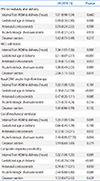1. Sentilhes L, Sénat MV, Ancel PY, Azria E, Benoist G, Blanc J, et al. Prevention of spontaneous preterm birth: guidelines for clinical practice from the French College of Gynaecologists and Obstetricians (CNGOF). Eur J Obstet Gynecol Reprod Biol. 2017; 210:217–224.

2. Chan E, Quigley MA. School performance at age 7 years in late preterm and early term birth: a cohort study. Arch Dis Child Fetal Neonatal Ed. 2014; 99:F451–F457.
3. Nayot D, Penava D, Da Silva O, Richardson BS, de Vrijer B. Neonatal outcomes are associated with latency after preterm premature rupture of membranes. J Perinatol. 2012; 32:970–977.

4. Moster D, Lie RT, Markestad T. Long-term medical and social consequences of preterm birth. N Engl J Med. 2008; 359:262–273.

5. Teune MJ, Bakhuizen S, Gyamfi Bannerman C, Opmeer BC, van Kaam AH, van Wassenaer AG, et al. A systematic review of severe morbidity in infants born late preterm. Am J Obstet Gynecol. 2011; 205:374.

6. Wang ML, Dorer DJ, Fleming MP, Catlin EA. Clinical outcomes of near-term infants. Pediatrics. 2004; 114:372–376.

7. Rogers CE, Lenze SN, Luby JL. Late preterm birth, maternal depression, and risk of preschool psychiatric disorders. J Am Acad Child Adolesc Psychiatry. 2013; 52:309–318.

8. Woythaler MA, McCormick MC, Smith VC. Late preterm infants have worse 24-month neurodevelopmental outcomes than term infants. Pediatrics. 2011; 127:e622–e629.

9. Mathews TJ, MacDorman MF. Infant mortality statistics from the 2006 period linked birth/infant death data set. Natl Vital Stat Rep. 2010; 58:1–31.
10. Morse SB, Zheng H, Tang Y, Roth J. Early school-age outcomes of late preterm infants. Pediatrics. 2009; 123:e622–e629.

11. Santos IS, Matijasevich A, Domingues MR, Barros AJ, Victora CG, Barros FC. Late preterm birth is a risk factor for growth faltering in early childhood: a cohort study. BMC Pediatr. 2009; 9:71.

12. Goldenberg RL, Rouse DJ. Prevention of premature birth. N Engl J Med. 1998; 339:313–320.

13. Mercer BM, Goldenberg RL, Meis PJ, Moawad AH, Shellhaas C, Das A, et al. The preterm prediction study: prediction of preterm premature rupture of membranes through clinical findings and ancillary testing. The National Institute of Child Health and Human Development Maternal-Fetal Medicine Units Network. Am J Obstet Gynecol. 2000; 183:738–745.
14. Cox SM, Williams ML, Leveno KJ. The natural history of preterm ruptured membranes: what to expect of expectant management. Obstet Gynecol. 1988; 71:558–562.
15. Gibbs RS, Blanco JD. Premature rupture of the membranes. Obstet Gynecol. 1982; 60:671–679.
16. Mercer BM. Preterm premature rupture of the membranes. Obstet Gynecol. 2003; 101:178–193.

17. Furman B, Shoham-Vardi I, Bashiri A, Erez O, Mazor M. Clinical significance and outcome of preterm prelabor rupture of membranes: population-based study. Eur J Obstet Gynecol Reprod Biol. 2000; 92:209–216.

18. Goldenberg RL, Nelson KG, Davis RO, Koski J. Delay in delivery: influence of gestational age and the duration of delay on perinatal outcome. Obstet Gynecol. 1984; 64:480–484.
19. Kuba K, Bernstein PS. ACOG practice bulletin no. 188: prelabor rupture of membranes. Obstet Gynecol. 2018; 131:1163–1164.

20. Packard RE, Mackeen AD. Labor induction in the patient with preterm premature rupture of membranes. Semin Perinatol. 2015; 39:495–500.

21. Mackeen AD, Seibel-Seamon J, Muhammad J, Baxter JK, Berghella V. Tocolytics for preterm premature rupture of membranes. Cochrane Database Syst Rev. 2014; (2):CD007062.

22. Naef RW 3rd, Allbert JR, Ross EL, Weber BM, Martin RW, Morrison JC. Premature rupture of membranes at 34 to 37 weeks' gestation: aggressive versus conservative management. Am J Obstet Gynecol. 1998; 178(1 Pt 1):126–130.

23. Buchanan SL, Crowther CA, Levett KM, Middleton P, Morris J. Planned early birth versus expectant management for women with preterm prelabour rupture of membranes prior to 37 weeks' gestation for improving pregnancy outcome. Cochrane Database Syst Rev. 2010; (3):CD004735.

24. van der Ham DP, van der Heyden JL, Opmeer BC, Mulder AL, Moonen RM, van Beek JH, et al. Management of late-preterm premature rupture of membranes: the PPROMEXIL-2 trial. Am J Obstet Gynecol. 2012; 207:276.

25. van der Ham DP, Vijgen SM, Nijhuis JG, van Beek JJ, Opmeer BC, Mulder AL, et al. Induction of labor versus expectant management in women with preterm prelabor rupture of membranes between 34 and 37 weeks: a randomized controlled trial. PLoS Med. 2012; 9:e1001208.

26. Aliaga S, Price W, McCaffrey M, Ivester T, Boggess K, Tolleson-Rinehart S. Practice variation in late-preterm deliveries: a physician survey. J Perinatol. 2013; 33:347–351.

27. Pike KC, Lucas JS. Respiratory consequences of late preterm birth. Paediatr Respir Rev. 2015; 16:182–188.

28. Boyle EM, Poulsen G, Field DJ, Kurinczuk JJ, Wolke D, Alfirevic Z, et al. Effects of gestational age at birth on health outcomes at 3 and 5 years of age: population based cohort study. BMJ. 2012; 344:e896.

29. van der Ham DP, van Kuijk S, Opmeer BC, Willekes C, van Beek JJ, Mulder AL, et al. Can neonatal sepsis be predicted in late preterm premature rupture of membranes? Development of a prediction model. Eur J Obstet Gynecol Reprod Biol. 2014; 176:90–95.

30. Hunt CE. Ontogeny of autonomic regulation in late preterm infants born at 34-37 weeks postmenstrual age. Semin Perinatol. 2006; 30:73–76.

31. Arnon S, Dolfin T, Litmanovitz I, Regev R, Bauer S, Fejgin M. Preterm labour at 34--36 weeks of gestation: should it be arrested? Paediatr Perinat Epidemiol. 2001; 15:252–256.

32. Henderson-Smart DJ, Pettigrew AG, Campbell DJ. Clinical apnea and brain-stem neural function in preterm infants. N Engl J Med. 1983; 308:353–357.

33. Pasquier JC, Picaud JC, Rabilloud M, Claris O, Ecochard R, Moret S, et al. Neonatal outcomes after elective delivery management of preterm premature rupture of the membranes before 34 weeks' gestation (DOMINOS study). Eur J Obstet Gynecol Reprod Biol. 2009; 143:18–23.

34. Tsafrir Z, Margolis G, Cohen Y, Cohen A, Laskov I, Levin I, et al. Conservative management of preterm premature rupture of membranes beyond 32 weeks' gestation: is it worthwhile? J Obstet Gynaecol. 2015; 35:585–590.








 PDF
PDF ePub
ePub Citation
Citation Print
Print



 XML Download
XML Download